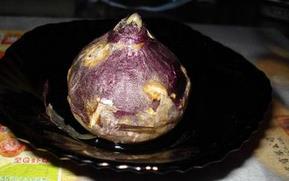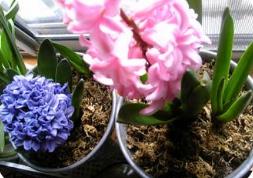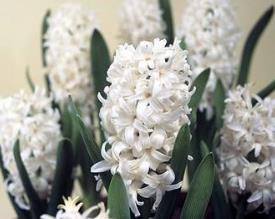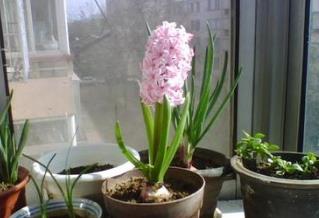How to grow hyacinth well
Do you know how to grow hyacinth well? if you have hyacinth at home, here are some specific methods. I hope it will be helpful to you.

How to grow hyacinth well
Hyacinth planting balls, many flower friends who see them for the first time will often think it is a small onion, hehe. Different varieties of hyacinth seed coat color, shape, appearance and so on will be very different. Some are very round, some seed coat will have cracking and so on, it is a normal phenomenon.
There is a seed coat on the outside of the hyacinth sphere, which has a certain protective effect on the sphere itself, and there is no need to peel off the seed coat when planting. Of course, there are exceptions, because it has come all the way across the sea and has been floating on the sea for more than a month, so hyacinths are generally more or less moldy. Mildew is generally related to varieties, some varieties may rarely have mildew spots, and some are almost all moldy. If there are more mildew spots, you can peel off the epidermis properly, wash the sphere with clean water and soak it with carbendazim solution before planting. Mildew of the epidermis has no effect on normal growth and flowering.

The package of planting supplies includes carbendazim for planting peat, disinfecting bulbs, bone powder for promoting flower bud differentiation, high phosphorus content, slow-release functional fertilizer for Aibei, which is effective throughout the growing period of the bulb; gloves for the prevention of allergies some people are allergic to hyacinths, the symptoms are itching, erythema and so on, so it is recommended to wear gloves for operation. If you have allergies, please see a doctor immediately.
There are many dry fibrous roots in the root disc at the bottom of the bulb, which need to be cleaned before planting in order to expose the root disc and grow new roots. In particular, it is forbidden to use any knife for cutting, cutting, etc., if the root disc is damaged or damaged, it will not be able to grow new roots, affecting the growth and germination of the seed ball. It is recommended to clean up these dry old roots by hand and remember to wear gloves.
After the root disk is cleaned, you can clearly see a circle of flesh-colored parts around it, that is, the place where new roots grow, which must not be cut with a knife.
For the preparation of the flowerpot, first put a cushion net on the bottom of the pot to prevent the soil from leaking and prevent all kinds of pests from drilling into the flowerpot.
Add a layer of medium light stone on top. Its function is conducive to drainage, ventilation, prevent rotting roots and other phenomena.
For the preparation of planting soil, add an appropriate amount of Aibei slow-release functional fertilizer in Fadao No. 1 and mix well.
Add bone meal and mix well. The high phosphorus content of bone powder and no root burning are helpful to promote flower bud differentiation of bulbs.
What it looks like after planting. Please note that the depth of the soil cover is so that the sphere is slightly exposed to the soil surface 1-2cm or so.
After planting, pour it thoroughly and be sure to get wet through.
Many people say that hyacinth needs shading to promote its roots after it is first planted, but this is not entirely true. Hyacinth cultivated in soil does not need any shading treatment. on the contrary, we suggest that we should bask in the sun and pay attention to ventilation to avoid further mildew of the sphere; if it is hydroponic, it can theoretically promote root growth through shading. According to our years of actual contrast experiments, there is not much difference, so it does not make much sense.
Hyacinth is a variety planted in autumn, which needs to undergo low temperature in winter and flower bud catalysis in order to bloom normally. So there's basically nothing going on for a month now. Now all you have to do is wait patiently.

Here are some key points of hydroponic hyacinth:
The preliminary treatment of the bulb is the same as the soil culture, mainly the treatment of the old root in the root disc and the disinfection of the bulb, which will not be repeated.
The height of the water level before rooting is critical and should not be too high, otherwise the sphere is prone to mildew. As shown in the following picture, the water level is slightly high and a water film is formed between the sphere and the bottle in the red circle, which is easy to cause mildew here.
Slightly lower the water level, basically only the root disc is not in the water, as shown in the following picture, which can ensure normal hairy roots. It is worth mentioning that too low water level is not good, it will cause uneven root, for example, only half of the whole root disk has roots, but the other half does not.
Hydroponic tools: hyacinth hydroponic bottle, ceramsite (decorative function), hydroponic nutrient solution
Start with the overall effect of hydroponics. Generally, you can root in a few days, and when the root system is slightly longer, you can lower the water level slightly so that the root disk is no longer in direct contact with water.
In the first month or so, because the temperature is still slightly higher, basically only grow roots, there will be no sprouting. What needs to be done at this time is to wait patiently.
Generally, you can change the water every 5 days or so, and at the same time, add some hydroponic nutrient solution, lift the sphere slightly and pour the water out. Especially after growing roots, you need to be more careful when operating to avoid breaking the roots. Its roots are non-renewable. Of course, even if you accidentally break one or two roots, you don't have to be too nervous.
In addition, it should be mentioned that because the root system is easy to break and non-renewable, it can not be changed to soil culture midway after hydroponic culture.
Now we can almost start to buy hyacinth. The advantage of buying hyacinth now is that it hasn't sprouted. If you want to plant hyacinth, you can experience a sense of achievement. You can buy someone who has already sprouted or even seen flowers and arrows. It's really boring to raise them like this. And the biggest advantage is that the roots are generally not divided into pots, they are hyacinths that have just come in, there is a lot of room for choice, and the color is the most accurate at this time, this basket is blue, that basket is purple, and there is absolutely no mistake. When the root is in disorder, you can only look at the color of the arrows and buds. You can usually see a little color, and you can't be far away from the flowers.
The Spring Festival is early this year, so the soil cultivation can go down this week and next week to get some fat. Hydroponics grow faster and can be a little slower for a few days. I used to be a hyacinth in hydroponic culture, but hydroponic culture is very difficult to blossom year after year, and fertilizer and nutrition can't keep up with it. Now I change to soil culture. Soil culture seems to have an old paste before Y Sauce, saying to crush multivitamin and put it on the soil. Let the water take the nutrients down. I'll try.

How to choose a seed ball?
I made a comparison between the seed ball I saved last year and the one I just bought. If you read my post on how to save the seed ball in May this year, you should still remember the seed ball I saved.
How to grow hyacinth balls
1. Planting method: because it is not convenient to find soil in the city, I choose aquaculture, which is simple and convenient.
2. Planting utensils: usually when you buy hyacinth, you will send a special glass bottle, in which you can keep hyacinth seed balls.
3. Planting method: water raises hyacinth, rely on water, and change water once a week when you are in the mood. It should be noted that every time you change the water, you have to leave the water for a period of time, and then change the water for hyacinth, which is said to remove toxic substances from the water.
4. Planting time: I bought it in winter. It should be December. It won't blossom until February of next year. It takes almost two months to blossom. It feels a little long. The most obvious change you can see in the middle is that there are more and more white roots in the bottle.
5. Planting experience: seeing the hyacinth bulb growing so big, I have been thinking, why can it grow so big without nutrition in the water? Guess that all the nutrients needed for hyacinth growth are stored in the bulb, so there is no need for additional nutrients, as long as the environment is provided for it to grow.

Ecological habits of hyacinth
Like warm and humid winter, cool summer slightly dry, sunny or semi-overcast environment. Like fertilizer, suitable for fertile, well-drained sandy loam, avoid too wet or sticky soil. Hyacinth bulbs have the habit of dormancy in summer, take root in autumn and winter, sprout in early spring, blossom in March, and wilt in early June. In the process of growth, the root growth of bulb was the best when the temperature was 2 ~ 6 ℃. The optimum temperature for bud germination was 5: 10 ℃, the optimum temperature for leaf growth was 10: 12 ℃, and the most favorable temperature for budding and flowering was 15: 18 ℃. The storage temperature of bulb is 20-28 ℃, and the optimum storage temperature is 25 ℃, which is the most ideal for flower bud differentiation.
The water requirement of hyacinth varies with its growth stage. During the rooting period of the bulb, it is better to be slightly moist, which is beneficial to the development of the root system, and water should be replenished in the case of drought, but the soil is too moist and the root system is easy to rot under the condition of low temperature. Sufficient water is needed during leaf growth and budding and flowering stage. The amount of water should be reduced in the full flowering period, and the bulb should stop watering in the dormant period to keep it dry.
Hyacinth leaves need sufficient sunshine in the early spring, and the flowering period can be prolonged by putting it in the semi-shade place after flowering. In promoting cultivation, sufficient sunlight is needed when the leaves grow to a certain height to promote the elongation of flower stems and accelerate flowering. The soil should be loose, fertile and well drained sandy loam, must not be too wet and heavy soil. Potted plants use the same amount of mixed substrate of peat, culture soil and sand.
Especially after growing roots, you need to be more careful when operating to avoid breaking the roots. Its roots are non-renewable. Of course, even if you accidentally break one or two roots, you don't have to be too nervous.
In addition, it should be mentioned that because the root system is easy to break and non-renewable, it can not be changed to soil culture midway after hydroponic culture.
Now we can almost start to buy hyacinth. The advantage of buying hyacinth now is that it hasn't sprouted. If you want to plant hyacinth, you can experience a sense of achievement. You can buy someone who has already sprouted or even seen flowers and arrows. It's really boring to raise them like this. And the biggest advantage is that the roots are generally not divided into pots, they are hyacinths that have just come in, there is a lot of room for choice, and the color is the most accurate at this time, this basket is blue, that basket is purple, and there is absolutely no mistake. When the root is in disorder, you can only look at the color of the arrows and buds. You can usually see a little color, and you can't be far away from the flowers.
The Spring Festival is early this year, so the soil cultivation can go down this week and next week to get some fat. Hydroponics grow faster and can be a little slower for a few days. I used to be a hyacinth in hydroponic culture, but hydroponic culture is very difficult to blossom year after year, and fertilizer and nutrition can't keep up with it. Now I change to soil culture. Soil culture seems to have an old paste before Y Sauce, saying to crush multivitamin and put it on the soil. Let the water take the nutrients down. I'll try.

How to choose a seed ball?
I made a comparison between the seed ball I saved last year and the one I just bought. If you read my post on how to save the seed ball in May this year, you should still remember the seed ball I saved.
How to grow hyacinth balls
1. Planting method: because it is not convenient to find soil in the city, I choose aquaculture, which is simple and convenient.
2. Planting utensils: usually when you buy hyacinth, you will send a special glass bottle, in which you can keep hyacinth seed balls.
3. Planting method: water raises hyacinth, rely on water, and change water once a week when you are in the mood. It should be noted that every time you change the water, you have to leave the water for a period of time, and then change the water for hyacinth, which is said to remove toxic substances from the water.
4. Planting time: I bought it in winter. It should be December. It won't blossom until February of next year. It takes almost two months to blossom. It feels a little long. The most obvious change you can see in the middle is that there are more and more white roots in the bottle.
5. Planting experience: seeing the hyacinth bulb growing so big, I have been thinking, why can it grow so big without nutrition in the water? Guess that all the nutrients needed for hyacinth growth are stored in the bulb, so there is no need for additional nutrients, as long as the environment is provided for it to grow.

Ecological habits of hyacinth
Like warm and humid winter, cool summer slightly dry, sunny or semi-overcast environment. Like fertilizer, suitable for fertile, well-drained sandy loam, avoid too wet or sticky soil. Hyacinth bulbs have the habit of dormancy in summer, take root in autumn and winter, sprout in early spring, blossom in March, and wilt in early June. In the process of growth, the root growth of bulb was the best when the temperature was 2 ~ 6 ℃. The optimum temperature for bud germination was 5: 10 ℃, the optimum temperature for leaf growth was 10: 12 ℃, and the most favorable temperature for budding and flowering was 15: 18 ℃. The storage temperature of bulb is 20-28 ℃, and the optimum storage temperature is 25 ℃, which is the most ideal for flower bud differentiation.
The water requirement of hyacinth varies with its growth stage. During the rooting period of the bulb, it is better to be slightly moist, which is beneficial to the development of the root system, and water should be replenished in the case of drought, but the soil is too moist and the root system is easy to rot under the condition of low temperature. Sufficient water is needed during leaf growth and budding and flowering stage. The amount of water should be reduced in the full flowering period, and the bulb should stop watering in the dormant period to keep it dry.
Hyacinth leaves need sufficient sunshine in the early spring, and the flowering period can be prolonged by putting it in the semi-shade place after flowering. In promoting cultivation, sufficient sunlight is needed when the leaves grow to a certain height to promote the elongation of flower stems and accelerate flowering. The soil should be loose, fertile and well drained sandy loam, must not be too wet and heavy soil. Potted plants use the same amount of mixed substrate of peat, culture soil and sand.
Related
- Wuhan Hospital Iron Tree Blooming Result Was Instantly Frightened by the Gardener Master
- Which variety of camellia is the most fragrant and best? Which one do you like best?
- What is the small blue coat, the breeding methods and matters needing attention of the succulent plant
- Dormancy time and maintenance management of succulent plants during dormancy
- Minas succulent how to raise, Minas succulent plant pictures
- What are the varieties of winter succulent plants
- How to raise succulent plants in twelve rolls? let's take a look at some experience of breeding twelve rolls.
- Attention should be paid to water control for succulent plants during dormant period (winter and summer)
- Watering experience of twelve rolls of succulent plants
- Techniques for fertilizing succulent plants. An article will let you know how to fertilize succulent plants.



